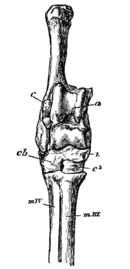the facts of Ungulate descent are absolutely destructive of any such comparisons.
As is the case with the Perissodactyles, the Artiodactyles show a historical series, the primitive five-toed condition being almost preserved in Oreodon, up to the most modern modification exemplified by the Ox, Sheep, etc., in which animals there are not even vestiges of the fourth and fifth toes. It has been stated, however, that the foetal Sheep has traces of those rudiments. The so-called cannon bone (the fused third and fourth metapodia) is accompanied in its fusion by an increase in length. At the same time the functional middle metacarpals push aside the rudiments and, forming a broad surface for that purpose, articulate with the magnum and unciform bones to the exclusion of the rudiments. This has been termed an "adaptive reduction." In the "inadaptive reduction" there is the same reduction of the metacarpals, but the rudiments still articulate as in the primitive Artiodactyle foot, i.e. Mc II with trapezium, trapezoid, and magnum; Mc III with magnum and unciform; Mc IV and V with unciform. This would appear to give greater solidity and consequently greater strength to the foot.

Fig. 139.—Dorsal surface of right tarsus of Red Deer (Cervus elaphus). × ⅓. a, Astragalus; c, calcaneum; c3, cuneiform; cb, cuboid; mIII, mIV, metatarsals; n, navicular. (From Flower's Osteology.)
The carpal bones of the Artiodactyla alternate in their articulation; the primitive state of affairs[1] is not retained even in the earliest types. The femur has no third trochanter, so prevalent in the Perissodactyles. In the hind-foot the calcaneum has an articular facet for the fibula, which is not characteristic of the Perissodactyla. In the more modern forms, e.g. the Cervidae, the navicular and cuboid become fused into one bone; and there are even further fusions which will be referred to later as characteristic features of different groups. It is interesting to notice that the reduction begins earlier and is clearer in the hind-foot than in the fore. One
- ↑ See, however, p. 196, for a discussion as to which is the more primitive arrangement.
